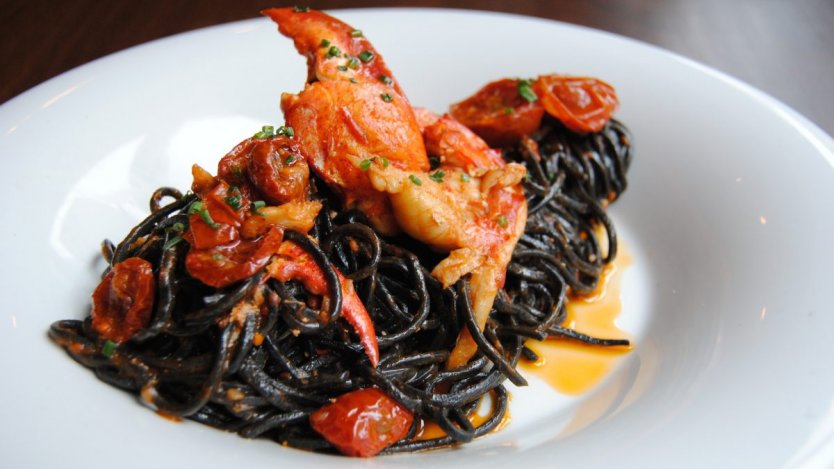Chef Luca Stracquadanio is known for his simple and elegant Italian food at Ovest Cucina e Vineria. If you're a fan of its squid ink pasta and you're feeling ambitious, you can attempt to make it at home with this recipe.
Some tips from the chef:
- When selecting lobsters make sure they are lively. The freshness of the lobster is key in this dish.
- For the squid ink, most reputable fishmongers in the city carry this product, either refrigerated or frozen. If you are having issues sourcing this ingredient, try smaller fish shops and ethnic food markets in your city.
Squid ink pasta
Combine all of the ingredients in a stand mixer with a dough hook attachment and mix on low speed for 10 minutes. The dough should come together within 2-3 minutes of mixing. If the dough appears to be wet, add 1 to 2 tbsp of flour. If the dough seems dry and crumbles, add 1 to 2 tbsp of water. The dough should combine and be firm and resist when you push your finger into it.
Once the pasta is mixed wrap it with plastic wrap and allow it to rest for 30 to 60 minutes.
Using an electric or hand powered pasta machine, roll the sheets of pasta out to 2mm in thickness. Start on the highest number and work your way down one number at a time on the dial of thickness until you achieve 2mm.
Once you have the pasta rolled out, divide the sheet into 4 equal portions. If you have a cutting attachment for tagliolini, then use that. If not, flour the sheets of pasta, fold in half, flour again and fold in half. Using a sharp knife, cut fine ribbons 2-3mm in thickness. Separate the strands of pasta and dust in flour to prevent clumping. Store pasta covered in the fridge until ready to use.
Lobster stock
Bring 10 to 12 litres of salted water to a boil and blanch the lobster (7mins for one pound, 10mins for one and a half pounds).
Remove lobsters and plunge in a bowl of iced water to stop the cooking. Once the lobsters are cooled, remove the tail, knuckle and claw meat. Keep the tail and claw meat intact for presentation. Cut the lobster tails in half length-wise.
If the lobsters are slightly undercooked they will finish cooking in the final sauce.
With the shells from the cleaned lobster, combine the rest of the ingredients with 4 litres of water in a pot and allow to gently simmer for 1 hour.
Strain the stock through a fine strainer and allow it to cool before storing. Lasts 3 days in the fridge.
Sauce
Sautéing the shallots in extra virgin olive oil for 1-2 minutes on medium heat. Add the cured cherry tomatoes; if those are unavailable, add chopped sundried tomatoes and sauté for an additional minute to release the flavour into the oil.
Add the tomato puree/sauce to stop the cooking of the shallots then add the finished lobster stock. Reduce the liquid by 1/8. While reducing the sauce add the lobster meat once nearly done to heat and cook through if needed.
To Serve
Bring 6 litres of salted water to a boil. Cook the fresh pasta for 2-3 minutes. Drain and reserve one cup of the pasta water.
To the pan with sauce, add cooked pasta and butter. Cook for an additional 1-2 minutes, glazing the pasta with the sauce. Add a few spoons of the pasta water if necessary to thin the sauce out if it has over reduced.
Divide the pasta into 4 pasta bowls or plates. Garnish the tops of the pasta with the cherry tomatoes and lobster tails and claws. Add finely cut chives to garnish.
Serve immediately.







